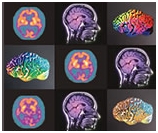Patient M.L.: Episodic autobiographical amnesia
Using high resolution, three-dimensional structural MRI, we documented an area of focal brain damage in the frontal projections of the right uncinate fasciculus, a frontal-temporal band of fibers previously identified as important to the retrieval of personal past memories. We investigated the effects of this damage on brain function during memory performance in two functional neuroimaging studies. These studies provided evidence to link M.L.'s self-reported subjective disconnection from anterograde events to deficits in specific neurocognitive systems with established functional neuroanatomy in healthy adults.
Although M.L.'s anterograde learning and memory performance were normal, we reasoned that the processes underlying this performance may have been affected by the right frontal lobe injury. Using positron emission tomography (PET), we documented reduced right frontal blood flow and increased left hippocampal blood flow (Image) relative to controls during performance of an episodic memory retrieval task. These findings suggested altered functional neuroanatomy of anterograde memory processes. Behavioral correlation with these neuroanatomical findings was sought using the remember/know technique, a self-report measure of re-experiencing past events. M.L. reported fewer "remember" responses, corresponding to reduced re-experiencing of previously studied material. His intact memory test performance was instead supported by preserved semantic processes ("know" responses).
While this study illuminated M.L.'s brain function during laboratory memory tasks, it did not directly address his main presenting problem of episodic autobiographical amnesia. We formally studied this by combining our prospective audio diary method for collection of autobiographical stimuli with the Autobiographical Interview scoring technique (Levine et al, 2009). M.L. created recordings of significant personal events over a ten month period. As expected, when presented with these recordings about nine months later, he reported reduced re-experiencing of these events relative to comparison subjects. Interestingly, "internal" or episodic autobiographical details were only marginally significantly lower than comparison subjects, suggesting that M.L. can produce episodic-like details in the absence of re-experiencing. When presented with the recordings during scanning with fMRI, M.L. showed reduced activation of elements of the autobiographical memory network, especially the in left medial prefrontal region (strongly implicated in self-related processes) and the posterior cingulate gyrus (important to mnemonic retrieval operations).
M.L. also showed evidence of impaired self-regulation in both real-life and laboratory tasks (Levine et al., 1999), suggesting that access to episodic autobiographical memory may be important for on-line behavioral regulation and decision making.
